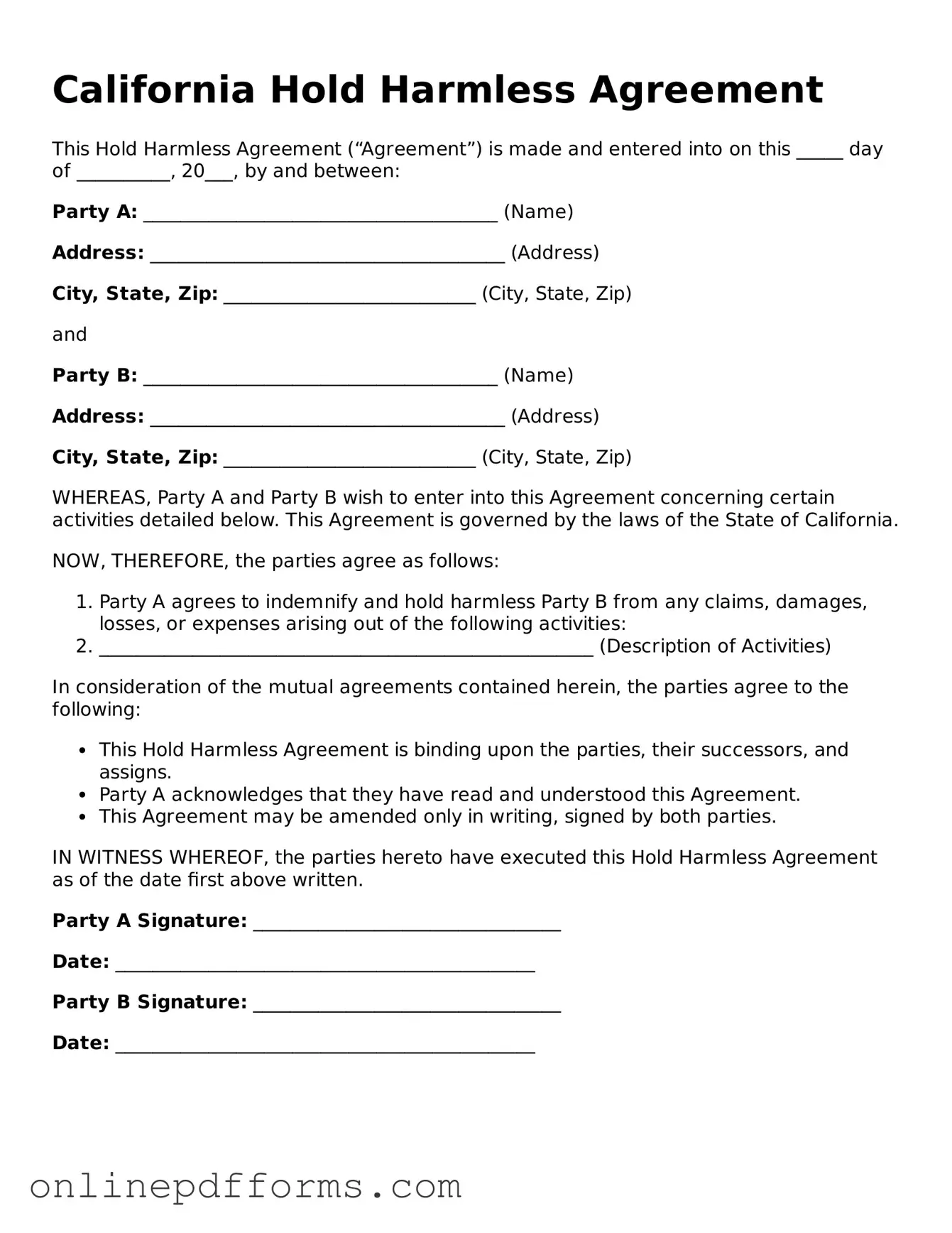The California Hold Harmless Agreement is often compared to a Waiver of Liability. Both documents serve to protect one party from legal claims or damages that may arise from an activity or event. In a Waiver of Liability, individuals typically agree not to hold an organization or individual responsible for any injuries or losses incurred during a specific activity. This type of agreement is frequently used in recreational settings, such as sports or outdoor activities, where participants acknowledge the risks involved and agree to assume responsibility for their own safety.
Another document similar to the Hold Harmless Agreement is the Indemnity Agreement. While both agreements aim to limit liability, an Indemnity Agreement specifically focuses on compensating one party for losses incurred due to the actions of another. In this case, one party agrees to cover costs associated with claims or damages that may arise from the other party's actions, whether intentional or negligent. This document is commonly used in business contracts, where one party may need to protect itself from potential lawsuits stemming from the other party's operations.
The Release of Liability form also shares similarities with the Hold Harmless Agreement. Both documents require individuals to relinquish their right to sue for damages. However, a Release of Liability typically applies to a specific event or activity, whereas a Hold Harmless Agreement can cover ongoing activities or a broader scope of interactions. For example, a participant might sign a Release of Liability before a bungee jumping event, while a Hold Harmless Agreement might be used by a contractor working on a construction site, covering all potential risks throughout the project.
A Service Agreement often parallels the Hold Harmless Agreement in that it may include clauses designed to limit liability. While a Service Agreement outlines the terms of a service provided, it can also incorporate hold harmless provisions to protect the service provider from claims arising out of the service rendered. This ensures that clients acknowledge their responsibility for any risks associated with the service, thus safeguarding the provider from potential legal repercussions.
The Non-Disclosure Agreement (NDA) can also bear similarities to the Hold Harmless Agreement, particularly in the context of protecting sensitive information. While NDAs primarily focus on confidentiality, they may include clauses that hold one party harmless from any claims arising from the unauthorized disclosure of proprietary information. In this sense, both documents aim to mitigate risk, albeit in different contexts—one through liability and the other through confidentiality.
A Partnership Agreement may include hold harmless provisions as well, especially when partners wish to clarify their responsibilities and liabilities. Such agreements outline the roles of each partner and can establish that one partner will not hold the other responsible for certain actions or decisions made during the partnership. This helps create a cooperative environment where partners can work together without fear of legal repercussions stemming from each other's decisions.
The Lease Agreement is another document that may contain hold harmless clauses, particularly in commercial real estate. Landlords often include these provisions to protect themselves from liability related to injuries or damages occurring on their property. Tenants, by signing the lease, agree to hold the landlord harmless for any incidents that may arise, thus ensuring that the landlord is shielded from certain legal claims.
In the context of employment, the Employment Agreement may also include hold harmless language. Employers often seek to protect themselves from claims related to employee actions during the course of employment. By incorporating hold harmless clauses, employers can ensure that employees acknowledge their responsibilities and agree not to hold the employer liable for certain actions taken in the workplace, thus fostering a clearer understanding of liability.
Finally, the Consent Form used in medical or therapeutic settings can be likened to the Hold Harmless Agreement. Patients often sign consent forms to acknowledge the risks associated with treatments or procedures. These forms may also include language that holds the healthcare provider harmless from claims arising from the patient's decision to proceed with the treatment. This ensures that patients are informed about potential risks while also protecting healthcare providers from legal claims related to those risks.
